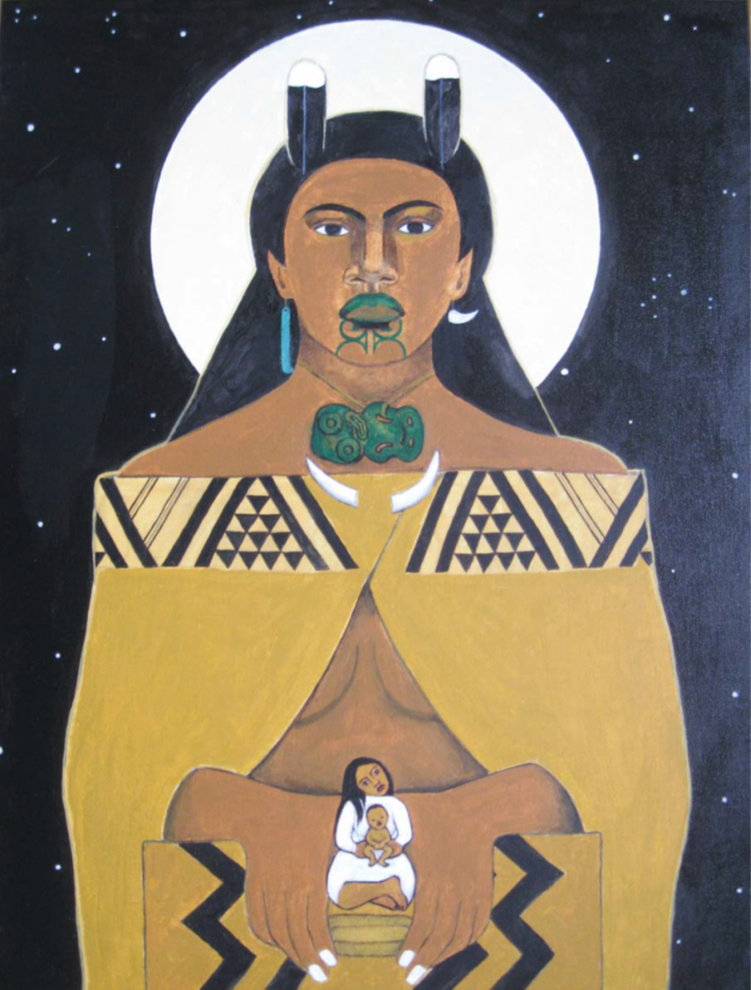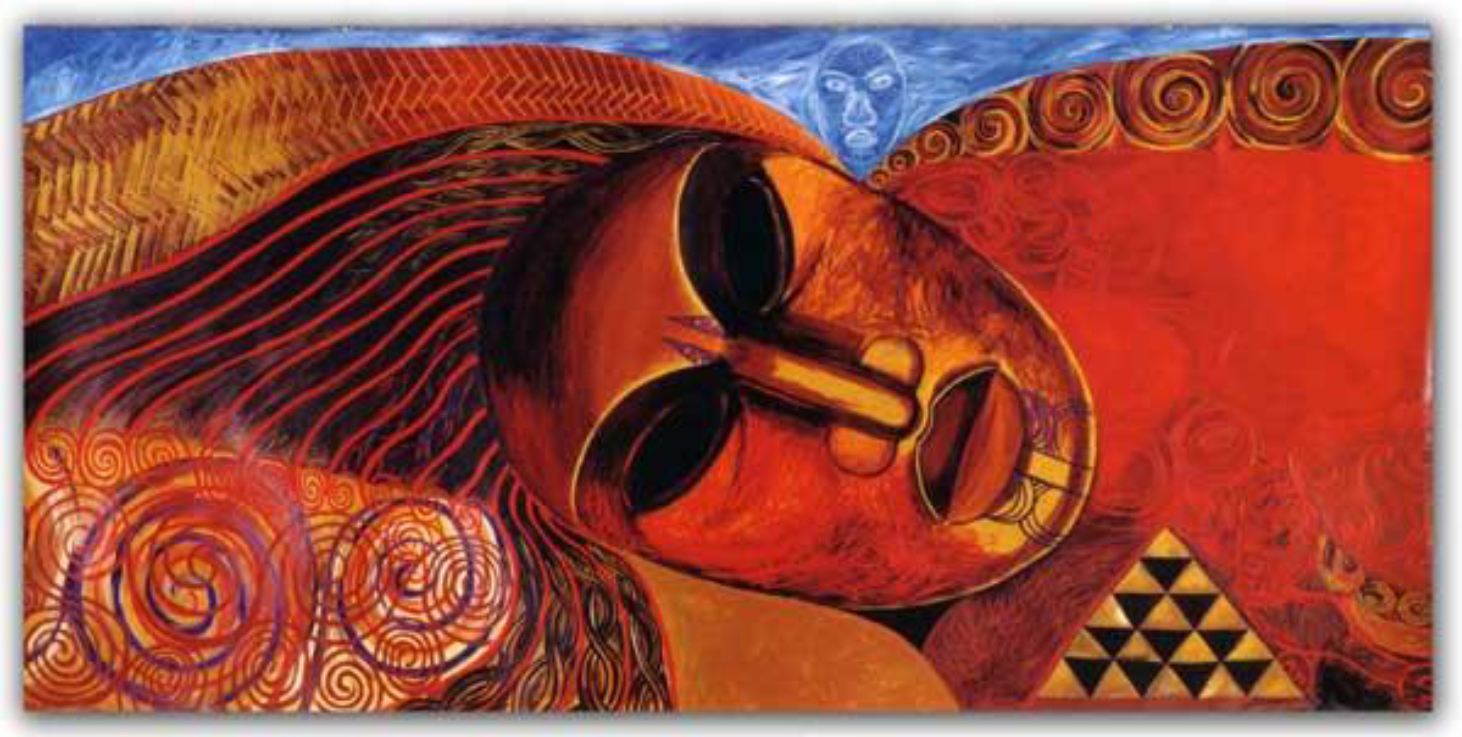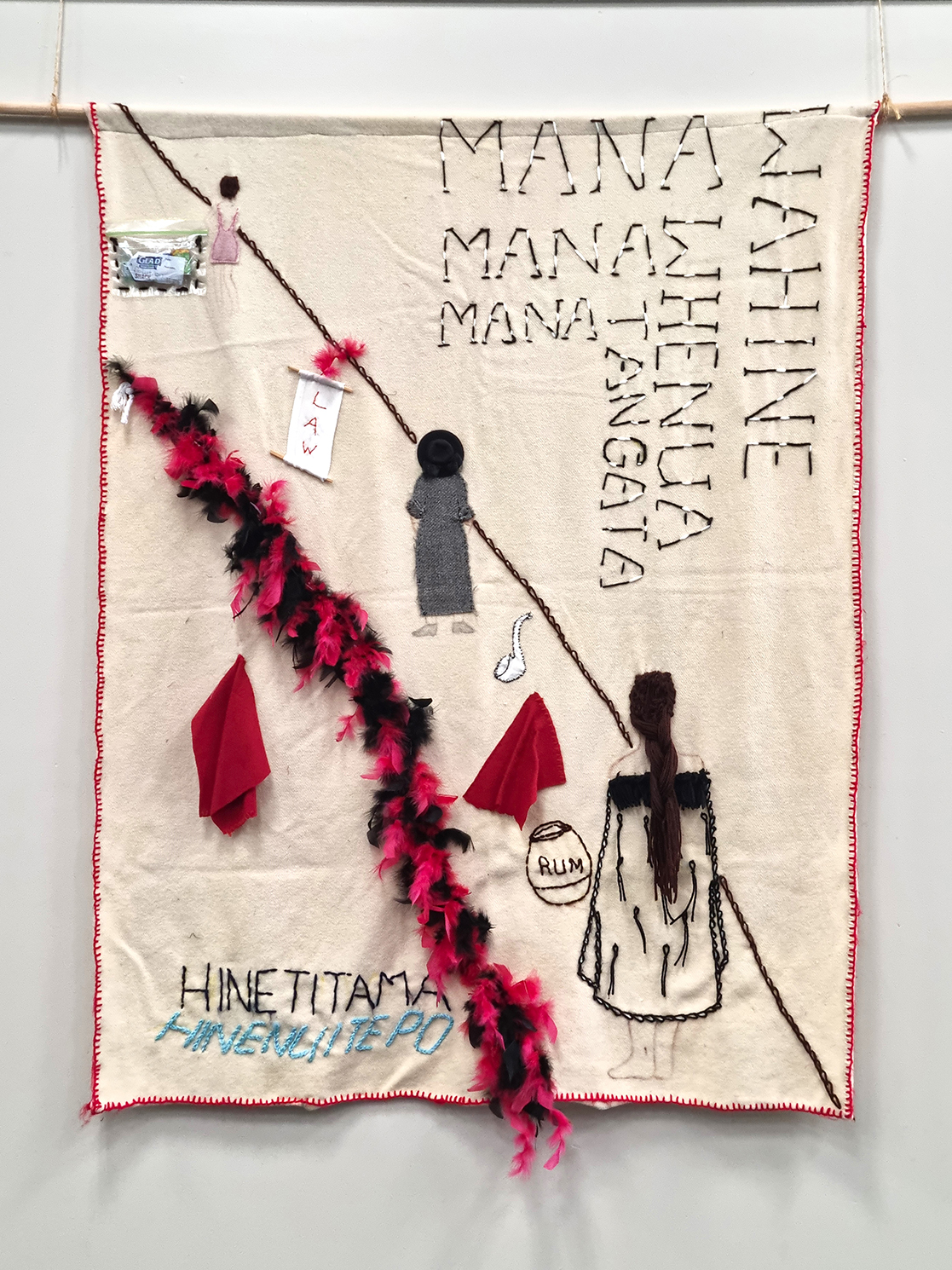How do traditional or reconstructed stories about atua whāea provide a blueprint for the mana and status of wāhine Māori in pre-1840 Māori society, and today?
I whai wāhi atu ngā pūrākau motuhake me ngā pūrākau kua whakatauritetia mō ngā atua whāea ki te tīmatanga o te mana o ngā wāhine Māori o ngā tau i mua i te tau 1840, ā mohoa noa nei? Pēhea nei?
The importance of atua wāhine to the roles and status of wāhine was a significant theme in the evidence of witnesses in the tūāpapa phase of the Mana Wāhine inquiry. As one witness, Donna Awatere-Huata, put it, ‘[m]ana atua is integral to the rangatiratanga of Māori women’ (doc A20, p 7).(external link) Witnesses described how wāhine whakapapa to atua wāhine and how their strength and characteristics flow into the status of wāhine in te ao Māori, both before colonisation and today.
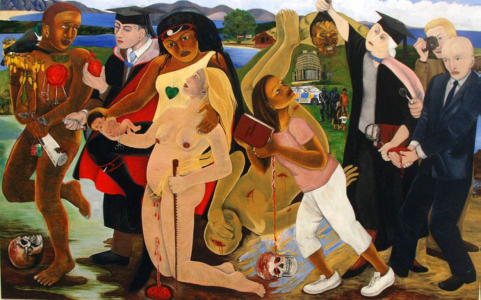
Power to Define, by Robyn Kahukiwa (2009) (pictured in document A30(c))
What witnesses said
- “This is the role of women, we are the keepers, the nurturers of man. Just like our atua whaea – Papatūānuku who provides us with shelter, sustenance and protection. It is women who are the gateway or the portal that has the ability to bring forth life into the physical realm from the spiritual dimension. Her body was made for this and prepared over the years for the demands of impending motherhood and beyond. After a tumultuous nine months of pregnancy, a women’s job does not end there – in fact, it is only the beginning. A mother’s job only ends when she takes her last breath. Until then she will endeavour to care for her descendants and those around her to the best of her abilities – all the while thinking of her future descendants to come.” (Hinerangi Cooper-Puru, doc A27, p 3)(external link)
- “Each of the atua have roles and responsibilities to keep the universe in order. As each Atua have roles, so do we. They are our role models, with their attributes and characteristics of strength, knowledge, and wisdom. Atua narratives provide insight into whānau relations and our society in general.” (Paula Ormsby, doc A55, 6)(external link)
- “Māui’s chosen strategy to achieve immortality—attempting to reverse the birthing process—is also significant. It clearly establishes the birth canal as a two-way conduit between Te Pō and Te Ao Mārama. Our creation theories establish the centrality of women to whānau, hapū and iwi, positioning them as agents of transition: between the physical and the metaphysical, between the unconscious and the conscious, between tapu and noa states, between life and death.” (Ani Mikaere, doc A17, p 4)(external link)
- “Whakapapa does not just include the genealogies but also the many wairua stories that flesh out the genealogical backbone. As wāhine, we stand in the power of the mana of the atua wahine, right down to our own personal mana which has been handed down as our birth right. From Papatuanuku we learn to stand on the solid ground of our own identity, from her we learn enduring love, and how to withstand the pain of separation. She teaches us to nurture and love our children regardless of the challenges they put us through. Hineahuone, the mother of Ira Tangata (human) formed from the sacred earth of Kurawaka. It is from her that the awesome sexual power of wāhine is derived, a power that men in power have tried to suppress since time immemorial. Through her we ascend beyond the ordinary to connect with the divine world of Atua. She enables us to go into that stillness within, where there is knowing that is pure. Here we can tap into this pure light and figuratively extend it to encompass and protect through the karanga.” (Deirdre Nehua, doc A25, p 4)(external link)
- “Our traditional creation stories are filled with examples of wahine toa. Papatuanuku, Hine-Titama and Hine Nui Te Po – just these few atua whaea who tell the story from the beginning of time, birth and creation through to the afterlife and thereafter. These stories are all closely associated and entwined with childbirth, fertility, manaakitanga and kaitiakitanga – such is the role of wahine.” (Lee Harris, doc A23, p 2)(external link)
- “What we know is that within each of these traditional stories, and their iwi renditions, is the affirmation and recognition of the sacred positioning of the female essence and the vital role of wahine in the creation of who we are now as whānau, hapū and iwi.” (Leonie Pihama, doc A19, pp 6-7)(external link)
- “Within this understanding of mana as originating within the spiritual realm, alongside our belief that humanity was formed through the power of atua, we are then able to more deeply connect that we are all both atua and tangata simultaneously. This is encapsulated in the phrase, ‘he atua, he tangata’ which Rangimarie Rose Pere relates to as; ‘I am both Celestial and Terrestrial, we all are, and we resonate in a way that is appropriate for each one of us.’” (Leonie Pihama, doc A19, p 8)(external link)
- “There are parallels to be drawn between the subordination of women and the subordination of Papatūānuku and nature, with the key principle of domination underlying modern attitudes towards both women and nature.” (Naomi Simmonds, doc A134, p 13)(external link)
- "Nga wahine pakeke I a koe, he atua. I heke mai te wahine I te atua, katoa o nga wahine o Aotearoa he atua. Heke mai ta ratou kawai whakapapa I te orokohanga o te ao, me mau te tika.” (Te Motoi Taputu, doc A50, p 4)(external link)
“All females older than myself I regard as ‘atua wahine’. Women are descended from atua, we must be vigilant in maintaining this fact." (Te Motoi Taputu, doc A50(a), p 4)(external link) - "Heke mai nga wahine Maori katoa I nga kawai whakapapa o nga atua, kei roto nga atua katoa J ia. He mana nui tona, kia maumahara te tangata ki tera, ko ia te tangata tuatahi o te ao. Ko ia tea ho tapu, te aho matua ki nga atua.” (Te Motoi Taputu, doc A50, p 6)(external link)
“All Māori females descend from atua, they reside in us. We have status, we have validity. Like the first creation Hineahuone, she is the sacred link, the paramount connection to our god spark." (Te Motoi Taputu, doc A50(a), p 6)(external link) - “Hine-tītama possessed great mana in her sacrifice and takes care of the descendants who have passed on. This is a reflection of the manner in which wāhine have endured a gradual process of being marginalised in whānau and hapū decisions and does not reflect the mana of wāhine tipuna throughout our Māori culture.” (Whirimako Black, doc A84, p 3)(external link)
- “Ko Hineteiwaiwa, ko Hinauri, ko Hina rāua ko Rona, ko Hine-kōtea, ko Hinekōrito, ko Hine-mākehu rāua ko Hine-korako ngā ingoa whakahua i e here ana ki te ora me ngā manawataki o te ora. E hono ana ki te hapūtanga me te whakawhānau, te whakatere, te whakatupu kai me wētahi āhuatanga maha o tea o māori. Ka here anō ki ngā wāhanga o te tau Māori ki te kāhui whetu o Matariki." (Hera Black-Te Rangi and Mareta Taute, doc A116, p 7)(external link)
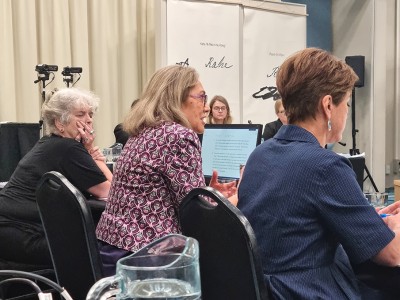
From left: Dr Robyn Anderson, Professor Linda Tuhiwai Smith, Judge Sarah Reeves at Turner Centre, Kerikeri, February 2021
